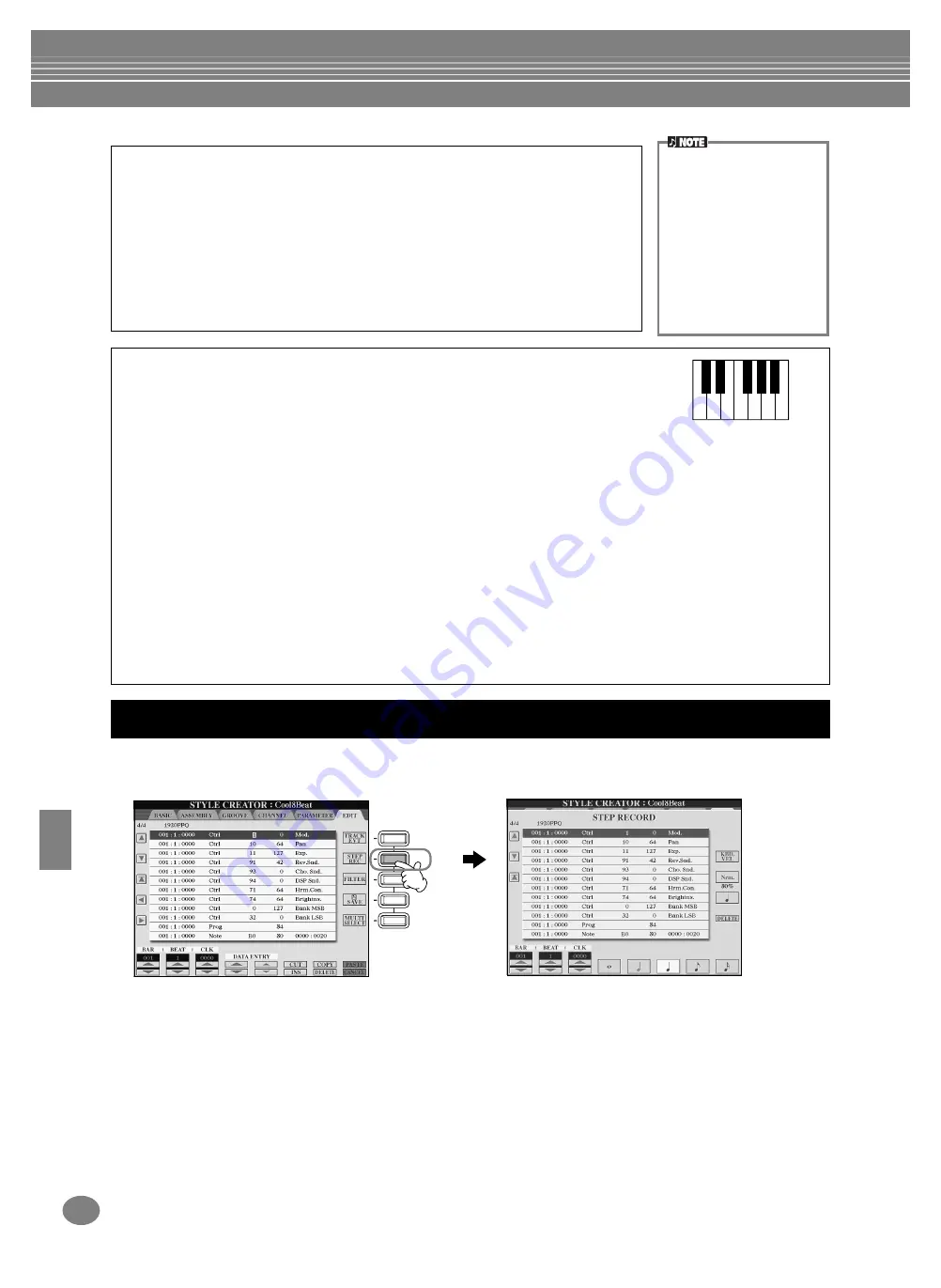
Creating Accompaniment Styles — Style Creator
CVP-210/208
116
With this method, you can create a style pattern by entering notes and other data individually, without having to
perform them in real time. The operations here apply to step 4 on page 114.
The actual recording process is the same as in Step Recording of songs (page 101), with the exception of the points
described below. You can also edit each event from the Edit page, and the editing process the same as in editing songs
(page 110).
• In song recording, the end mark position can be changed freely. However, it cannot be changed when creating
accompaniment styles. This is because the length of the accompaniment style is automatically fixed according to the
selected section. For example, when creating an accompaniment style based on a four-measure section, the end mark
position is automatically set to the end of the fourth measure, and cannot be changed from the Step Record screen.
• When editing the data recorded on the Edit page, you can switch between the type of data you want to edit (event
data or control data). Press the [F] (TRACK EVT) button to switch between the Event display (Note, Control Change,
etc.) and the Control display (System Exclusive, etc.).
Make sure to set the record channel from another display (e.g., BASIC display; page 115) beforehand.
Other Parameters in the BASIC Display
• [I] (SAVE) button
Calls up the Style display for saving the accompaniment style data.
• [3
▲▼
][4
▲▼
] (Section) buttons
Determines the section to be recorded.
• [5
▲▼
][6
▲▼
] (Pattern Length) buttons
Determines the length of the selected section’s pattern in measures (1 - 32). The
Fill In/Break section is fixed at a length of one measure.
• [D] (Execute) button
Executes the Pattern Length change.
Recording — Precautions
• The basic chord used for the accompaniment style is called the source chord. All
chords that play and the pitches that sound are derived from the source chord. When
recording the Main and Fill In sections (for a source chord of CM7), keep the
following points in mind:
* When recording to the Bass or Phrase channels, try to use only the recommended
notes; this will ensure that you can play various chords with the accompaniment
style and get optimum results. (Other notes may work, providing you use them as short passing tones.)
* When recording to the Chord or Pad channels, use only the notes of the CM7 chord; this will ensure that you
can play various chords with the accompaniment style and get optimum results. (Other notes may work,
providing you use them as short passing tones.)
The source chord is set by default to CM7; however, you can change this to any chord you prefer. Refer to the
section “Making Style File Format Settings – Parameter” on page 121.
• When recording Intro and Ending sections, you can ignore the source chord and use any notes or chord
progressions you like. In this case, if you set the NTR parameter to “ROOT TRANSPOSE” and NTT to
“HARMONIC MINOR” or “MELODIC MINOR” (in the PARAMETER page), the normal pitch conversions that
would result from playing different chords are cancelled (for playback) — meaning that the accompaniment
pitch conversion will only occur for changes in the root note or major/minor shifts.
You can also select the desired
section for recording by press-
ing the appropriate panel but-
ton. Pressing one of the
Section buttons calls up the
SECTION display, from which
you can change sections by
using the [6
▲▼
]/[7
▲▼
] but-
tons. To actually enter the
change, press the [8
▲
] button.
To select the Fill In section,
press the [AUTO FILL IN] but-
ton.
C R C
C R C
C = chord note
C, R = recommended note
Step Recording
F
J
I
H
G
Summary of Contents for Clavinova CVP-208
Page 175: ...MEMO 175 CVP 210 208 MEMO ...
Page 176: ...MEMO CVP 210 208 176 MEMO ...
















































